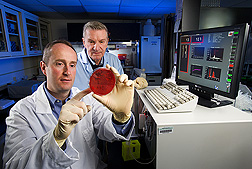This page has been archived and is being provided for reference purposes only. The page is no longer being updated, and therefore, links on the page may be invalid.
Read the magazine story to find out more. |
|
New Anti-Mastitis Weapon on Tap for Dairy Cows
By Jan SuszkiwFebruary 13, 2006
Injecting a sugar into cows' udders to mobilize an immune system response may give producers an alternative to antibiotics for fighting mastitis.
In trials at the Agricultural Research Service's (ARS) Bovine Functional Genomics Laboratory in Beltsville, Md., scientists Max Paape and Douglas Bannerman showed that injecting cows with the yeast sugar Poly-x reduced mastitis infection at one-twelfth the cost of antibiotics.
Their patent-pending approach is based on prior studies at the lab showing that increasing milk's white blood cell count will prevent infection by mastitis-causing bacteria. When injected into non-lactating dairy cows, Poly-x functions as a kind of bugle call that mobilizes the cells to attack mastitis pathogens.
During the trials, the scientists injected 40 non-milking Holstein cows with Poly-x and 40 with antibiotics. After the cows began lactating again, the scientists checked the animals for signs of mastitis infection. Those with Poly-x had a net gain of 5 new infections compared to 16 for antibiotic-treated cows, reports Paape, who, along with Bannerman, will publish the results.
ARS has applied for patent protection on the Poly-x treatment, and is seeking a commercial partner that can ready it for marketing to conventional and organic dairy producers.
Mastitis is an inflammation of cows' mammary glands that costs the U.S. dairy industry approximately $2 billion annually in both animal and dairy-production losses. Today's control programs include diagnostic testing, herd separation, animal culling, teat dips and antibiotic treatment. The latter, however, can be costly to use as well controversial because of environmental contamination and other concerns.
Paape and Bannerman see several advantages to using Poly-x as a natural alternative--the lack of residues being one. Expense is another: A tube of antibiotic costs about $2.50, compared to 20 cents for a Poly-x treatment.
Read more about the research in the February issue of Agricultural Research magazine.
ARS is the U.S. Department of Agriculture's chief scientific research agency.

